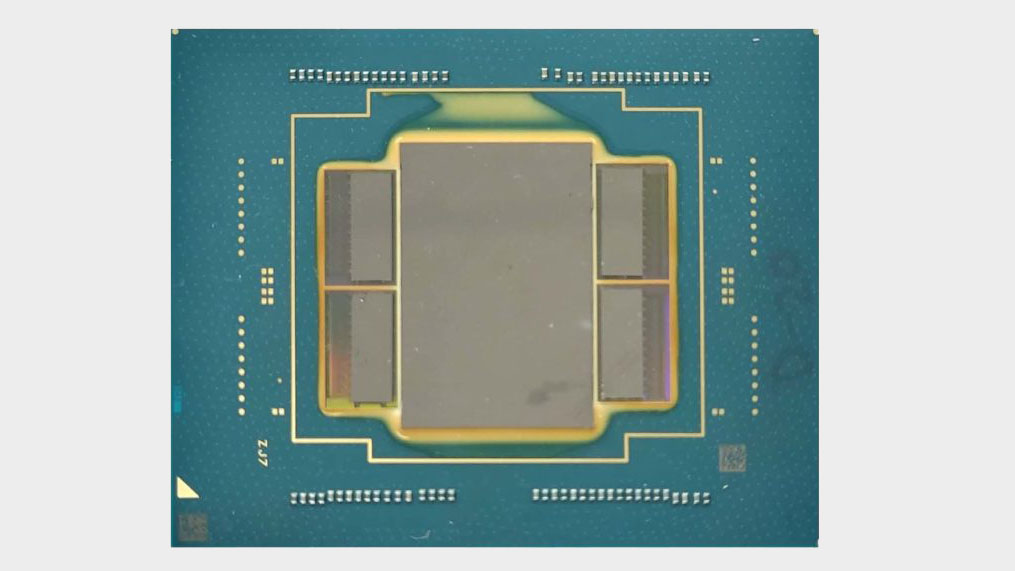Intel shows off a maths defying 8-core chip with 528 threads and optical interconnects
Hyper ultra mega threading.

Despite reports it is killing Hyperthreading in its upcoming desktop processors, Intel has shown off a new chip with an unfeasible number of threads coming off each core. Traditionally, you get two threads per core with the current simultaneous multi-threading on modern AMD and Intel CPUs, but this new optical chip is demonstrating 66 threads per core.
While optical interconnects and things like glass substrates are expected to become part of future chip manufacturing and packaging designs, it's this core design that really grabbed our attention. It's an 8-core chip. Pretty standard fare there, but it has 528 threads! That's 66 threads per core. Hyperthreading? More like super-mega-ultra-hyperthreading.
The annual Hot Chips conference took place this week. It's a forum for industry participants to discuss their latest and greatest tech, and give us a peek at what to expect in the future.
Serve The Home attended Hot Chips and reported on a CPU project presented by Intel. This chip was interesting for more than one reason. Firstly, the chip in question showed off a direct mesh to mesh photonic fabric. This technology could evolve to become be the future of advanced package interconnects, especially as the industry moves away from monolithic designs. The need for faster and lower latency chip or tile interconnects will become ever more important.
But optical tech isn't just for inter die communication. According to Intel, the tech can be used for multi processor communication, even between racks via a HyperX optical network, making this a very promising solution for highly scalable parallel workloads.
The chip in question isn't some exotic Frankenstein either. Apart from the optical router dies, it's quite similar to chips currently on the market. It's a multi-chip design, made with Intel's EMIB technology, with a 316mm² die area, 1.2 billion transistors and a TDP of just 75W. Most of that is taken up by the optical interconnects and routers.
Curiously, the chip was fabbed on TSMC's 7nm process, and not by Intel itself. It's also a RISC chip, and not based on the x86 architecture Intel historically specializes in.
The biggest gaming news, reviews and hardware deals
Keep up to date with the most important stories and the best deals, as picked by the PC Gamer team.

Best CPU for gaming: The top chips from Intel and AMD.
Best gaming motherboard: The right boards.
Best graphics card: Your perfect pixel-pusher awaits.
Best SSD for gaming: Get into the game ahead of the rest.
This kind of design is only suited to massively parallel workloads that don't stress the other parts of the core. Intel says the chip is useful for specific tasks such as DARPA's HIVE graph analytics tool. And, it can offer a 1000x improvement in performance per watt under those kinds of workloads compared to traditional compute solutions.
Impressive!
We aren't going to be seeing CPUs with very high thread counts in our gaming rigs anytime soon, though. Games prefer a few high-performance cores and lots of cache to very high thread counts. While the majority of gamers are using four or six core CPUs or laptops, it's hard to see game developers working to scale game performance across hundreds of threads any time soon.
Optical interconnect technology is something to keep an eye on. Several companies are working on similar tech. Latency is the enemy of gamers, and if inter-chiplet or inter-tile communications on the same package can be engineered to provide the same high bandwidth, low latency characteristics you'd get from a monolithic die, then bring it on!

Chris' gaming experiences go back to the mid-nineties when he conned his parents into buying an 'educational PC' that was conveniently overpowered to play Doom and Tie Fighter. He developed a love of extreme overclocking that destroyed his savings despite the cheaper hardware on offer via his job at a PC store. To afford more LN2 he began moonlighting as a reviewer for VR-Zone before jumping the fence to work for MSI Australia. Since then, he's gone back to journalism, enthusiastically reviewing the latest and greatest components for PC & Tech Authority, PC Powerplay and currently Australian Personal Computer magazine and PC Gamer. Chris still puts far too many hours into Borderlands 3, always striving to become a more efficient killer.

